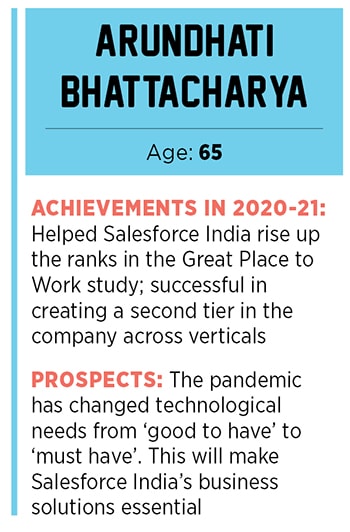
Arundhati Bhattacharya: Reinventing herself, again and again
From former banker to chairperson of Salesforce India, Bhattacharya is proof that corporate leaders can keep reinventing themselves, successfully
 Arundhati Bhattacharya CEO Salesforce India
Arundhati Bhattacharya CEO Salesforce India
Image: Neha Mithbawkar for Forbes India
Tough people take on tough situations as challenges to overcome. This is why former banker Arundhati Bhattacharya—who led the journey of India’s largest bank, State Bank of India (SBI), through its toughest phase—decided, at 64, to reinvent and challenge herself in the world of information technology. “Was I successful because I had walked into the readymade platform of SBI?” Bhattacharya questioned herself while choosing a new role.
Raw data does not reflect Bhattacharya’s impact in reshaping SBI. Gross non-performing assets for the bank rose 462 basis points to 10.35 percent in September-end 2017, a few days before her four-year leadership ended. Provision for bad loans rose to near 66 percent from 58 percent in the same period, hurting profitability.
But, in the same period, SBI had completed a massively difficult and sensitive mega merger of five associate banks with the parent in 2017. She also led SBI’s digital transformation, as contours of its successful digital banking app Yono were put in place during her tenure, alongside a tie-up with Amazon for payments and commerce solutions for small businesses.
Banking and IT may appear disparate but “services” is at the core of both businesses. And Bhattacharya knows enough about these. After a few months of working as non-executive director on corporate boards, Bhattacharya joined Salesforce in April 2020 and 18 months into the job, any self-doubts over her performance should start to disappear.
(This story appears in the 30 November, -0001 issue of Forbes India. To visit our Archives, click here.)




 Salesforce India never had a CEO until Bhattacharya joined; there were only senior vice president positions. Now she has created a full second tier, with sales and support functions; a chief people officer, finance officer, besides an innovation and strategic accounts posts. “Most of these were earlier shared functions across the Asia-Pacific region,” Bhattacharya says. It was not easy, there were five to seven revisions in the operations chart. They were brought into India operations as the business was getting
Salesforce India never had a CEO until Bhattacharya joined; there were only senior vice president positions. Now she has created a full second tier, with sales and support functions; a chief people officer, finance officer, besides an innovation and strategic accounts posts. “Most of these were earlier shared functions across the Asia-Pacific region,” Bhattacharya says. It was not easy, there were five to seven revisions in the operations chart. They were brought into India operations as the business was getting 




